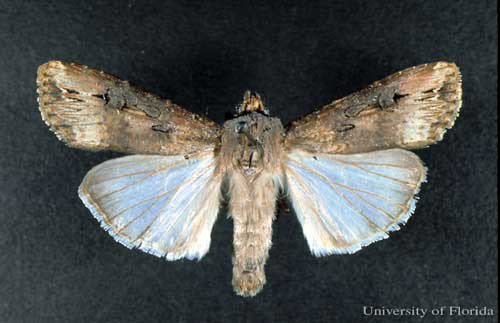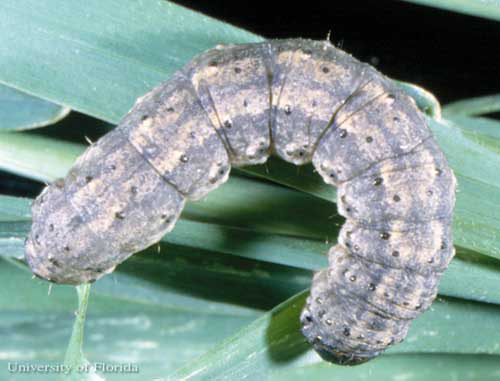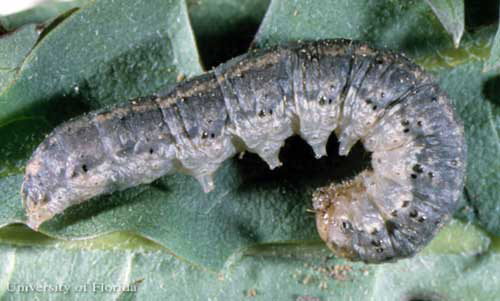common name: black cutworm
scientific name: Agrotis ipsilon (Hufnagel) (Insecta: Lepidoptera: Noctuidae)
Introduction - Distribution - Description and Life History - Host Plants - Damage - Natural Enemies - Management - Selected References
Introduction (Back to Top)
The black cutworm, Agrotis ipsilon (Hufnagel), has a wide host range, feeding on nearly all vegetables and many important grains, particularly corn.
Figure 1. Adult black cutworm, Agrotis ipsilon (Hufnagel). Photograph by John L. Capinera, University of Florida.
Distribution (Back to Top)
The origin of black cutworm is uncertain, though it is now found in many regions of the world, being absent principally from some tropical regions and cold areas. It is more widespread, and damaging, in the northern hemisphere than the southern hemisphere. It annually reinvades temperate areas, overwintering in warmer or subtropical regions.
Long distance dispersal of adults has long been suspected in Europe, China, and North America. The basic pattern is to move north in the spring, and south in the autumn. Studies in the United States demonstrated northward displacement of moths during the spring in the range of 1000 km in two to four days when assisted by northward flowing wind. Similar displacement to the south and southwest has been documented in the autumn.
Description and Life History (Back to Top)
The number of generations occurring annually varies with weather conditions. In North America, there are one to two generations in Canada but two to four in the United States. In Tennessee, USA, moths are present in March-May, June-July, July-August, and September-December. Based on light trap collections, moths are reported to be abundant in Arkansas, USA (a warm climate) during May-June and September-October, and in New York, USA ( a cool climate), they occur mostly in June-July. However, light traps are not very effective during the spring flight, and underestimate early season. Thus, the phenology of black cutworm remains uncertain, or perhaps is inherently variable due to the vagaries associated with long range dispersal.
Overwintering has been reported to occur in the pupal stage in most areas where overwintering occurs, but larvae persist throughout the winter in Florida, USA, a subtropical environment. Pupae have been known to overwinter as far north as Tennessee, but apparently are incapable of surviving farther north. Thus, moths collected in the central region of USA in March and April are principally dispersing individuals that are past their peak egg production period. Nonetheless, they inoculate the area and allow production of additional generations, including moths that disperse north into Canada. Duration of the life cycle is normally 35 to 60 days.
Adult: The adult is fairly large in size, with a wingspan of 40 to 55 mm. The forewing, especially the proximal two-thirds, is uniformly dark brown. The distal area is marked with a lighter irregular band, and a small but distinct black dash extends distally from the bean-shaped wing spot. The hind wings are whitish to gray, and the veins marked with darker scales. The adult preoviposition period is about seven to 10 days. Moths select low-growing broadleaf plants preferentially for oviposition, but lacking these will deposit eggs on dead plant material. Soil is an unsuitable oviposition site.
Egg: The egg is white in color initially, but turns brown with age. It measures 0.43 to 0.50 mm high and 0.51 to 0.58 mm wide and is nearly spherical in shape, with a slightly flattened base. The egg bears 35 to 40 ribs that radiate from the apex; the ribs are alternately long and short. The eggs normally are deposited in clusters on foliage. Females may deposit 1200 to 1900 eggs. Duration of the egg stage is three to six days.
Larva: There are five to nine instars, with a total of six to seven instars most common. Head capsule widths are about 0.26-0.35, 0.45-0.53, 0.61-0.72, 0.90-1.60, 2.1-2.8, 3.2-3.5, 3.6-4.3, and 3.7-4.1 mm for instars one through eight, respectively. Head capsule widths are very similar for instars one through four, but thereafter those individuals that display eight or nine instars show only small increments in width at each molt and eventually attain head capsule sizes no larger than those displaying only six or seven instars.
Larval body length is reported to be 3.5, 5.3-6.2, 7, 10, 20-30, 30-45, 50, and 50 mm for instars one through eight, respectively. Duration of the larval stage is normally 20 to 40 days. Mean duration of instars one through six was reported to be 6.0, 5.0, 4.6, 4.3, 5.6, 4.0 days, respectively, at 22°C. Larval development is strongly influenced by temperature, with the optimal temperature about 27°C. Humidity is less important, but instars one through five thrive best at higher humidities.
In appearance, the larva is rather uniformly colored on the dorsal and lateral surfaces, ranging from light gray or gray-brown to nearly black. On some individuals, the dorsal region is slightly lighter or brownish in color, but the larva lacks a distinct dorsal band. Ventrally, the larva tends to be lighter in color. Close examination of the larval epidermis reveals that this species bears numerous dark, coarse granules over most of its body. The head is brownish with numerous dark spots. Larvae usually remain on the plant until the fourth instar, when they become photo-negative and hide in the soil during the daylight hours. In these latter instars they also tend to sever plants at the soil surface, pulling the plant tissue belowground. Larvae tend to be cannibalistic.
Figure 2. Dorsal view of the larva of a black cutworm, Agrotis ipsilon (Hufnagel). Photograph by John L. Capinera, University of Florida.
Figure 3. Lateral view of the larva of a black cutworm, Agrotis ipsilon (Hufnagel). Photograph by John L. Capinera, University of Florida.
Pupa: Pupation occurs belowground at a depth of 3 to 12 cm. The pupa is 17 to 22 mm long and 5 to 6 mm wide, and dark brown. Duration of the pupal stage is normally 12 to 20 days.
Host Plants (Back to Top)
Black cutworm has a wide host range. Nearly all vegetables can be consumed, and this species also feeds on alfalfa, clover, cotton, rice, sorghum, strawberry, sugarbeet, tobacco, and sometimes grains and grasses. In the midwestern USA it is considered to be a serious corn pest. Among the weeds suitable for larval development are bluegrass, Poa pratensis; curled dock, Rumex crispus; lambsquarters, Chenopodium album; yellow rocket, Barbarea vulgaris; and redroot pigweed, Amaranthus retroflexus. The preference by black cutworm for weeds is sometimes quite pronounced, and crops will be attacked only after the weeds are consumed. Adults feed on nectar from flowers. Deciduous trees and shrub such as linden, wild plum, crabapple, and lilac are especially attractive to moths.
Damage (Back to Top)
This species occurs frequently in many crops, and is one of the best-known cutworms. Despite the frequency of occurrence, however, it tends not to appear in great abundance, as is known in some other cutworms and armyworms. Black cutworm is not considered to be a climbing cutworm, most of the feeding occurring at soil level. However, larvae will feed aboveground until about the fourth instar. Larvae can consume over 400 sq cm of foliage during their development, but over 80% occurs during the terminal instar, and about 10% in the instar immediately preceding the last. Thus, little foliage loss occurs during the early stages of development. Once the fourth instar is attained, larvae can do considerable damage by severing young plants, and a larva may cut several plants in a single night. Plants tend to outgrow their susceptibility to injury. Corn at the one-leaf stage is very susceptible to damage, but that by the 4 or 5-leaf stage plant yield was not reduced by larval feeding. Leaf feeding and cutting above the soil line are less damaging to corn than cutting at the soil surface. Subterranean damage is very injurious.
Natural Enemies (Back to Top)
Numerous species of natural enemies have been associated with black cutworm, but data on their relative importance are scarce. However, in Missouri, USA, there are reports of 69% parasitism, so natural enemies probably exact a significant toll on cutworm populations.
Among the wasps known to attack this cutworm are Apanteles marginiventris (Cresson), Microplitis feltiae Muesebeck, Microplitis kewleyi Muesebeck, Meteorus autographae Muesebeck, Meterorus leviventris (Wesmael) (all Hymenoptera: Braconidae); Campoletis argentifrons (Cresson), Campoletis flavicincta (Ashmead), Hyposoter annulipes (Cresson), and Ophion flavidus Brulle (all Hymenoptera: Ichneumonidae). Larvae parasitized by Meteorus leviventris (Wesmael) consume about 24% less foliage and cut about 36% fewer seedlings, so considerable benefit is derived from parasitism in addition to the eventual death of the host larva.
Other parasitoids known from black cutworm include flies often associated with other ground-dwelling noctuids, including Archytas cirphis Curran, Bonnetia comta (Fallen), Carcelia formosa (Aldrich and Webber), Chaetogaedia monticola (Bigot), Eucelatoria armigera (Coquillett), Euphorocera claripennis (Macquart), Gonia longipulvilli Tothill, G. sequax Williston, Lespesia archippivora (Riley), Madremyia saundersii (Williston), Sisyropa eudryae (Townsend), and Tachinomyia panaetius (Walker) (all Diptera: Tachinidae).
Predatory ground-dwelling insects such as ground beetles (Coleoptera: Carabidae) apparently consume numerous larvae.
Although studies in Florida, USA, indicated that 75 to 80% of cutworms could be killed by a granulosis virus, there is surprisingly little information on epidemiology and of natural pathogens. Rather, such pathogens as viruses, fungi, bacteria, and protozoa from other insects have been evaluated for black cutworm susceptibility; in most cases only relatively weak pathogens have been identified. However, in 1999 the Agrotis nucleopolyhedrosis virus was identified, and seems quite lethal to young larvae (Boughton et al. 2001).
An entomopathogenic nematode, Hexamermis arvalis (Nematoda: Mermithidae), is known to parasitize up to 60% of larvae in the central USA. Entomopathogenic nematodes (Nematoda: Steinernematidae and Heterorhabditidae) will infect and kill black cutworm larvae, but their populations normally need to be supplemented to realize high levels of parasitism. Their effectiveness is related to soil moisture conditions. An ectoparasitic nematode, Noctuidonema guyanense parasitized the adult stage, but its impact is uncertain.
Management (Back to Top)
Survey and Trapping. Adult populations can be monitored with both blacklight and sex pheromone traps. However, light traps are not consistently efficient. Light traps are most effective in the summer and autumn, but the late season generations generally pose little threat to crops. Pheromone traps are more effective during the spring flight, when larvae present the greatest threat to young plants. Trap color affects moth capture rate, with white and yellow traps capturing more than green traps.
Large larvae burrow in the soil, and are difficult to observe. However, larvae can be sampled with bait traps, and this is most effective prior to emergence or planting of seedlings. Various trap designs have been studied, but many employ a container sunk into the soil with the upper lip at the soil surface. The container is baited with fresh plant material and/or bran, and with vermiculite so the larvae can attain shelter. Larvae are effectively captured in baited containers if the vermiculite is not too near the surface, and catches are enhanced if a screen cylinder, which provides a visual stimulus to the cutworms, is suspended above the baited container. If plants are present in the field they compete with the bait in the traps, and trap efficiency declines markedly. The distribution of larvae in the spring is random.
Chemical. Persistent insecticides are commonly applied to plants and soil for black cutworm suppression, but surface rather than subsurface soil applications are desirable. Larvae readily accept insecticide-treated bran and other baits Application of systemic insecticides to seeds also provides some protection against larval injury. Bacillus thuringiensis is not usually recommended for cutworm control.
Cultural and Mechanical. Black cutworm larvae feed readily on weeds, and destruction of weeds can force larvae to feed exclusively on crop plants, exacerbating damage. Thus, it is often recommended that weeds not be tilled or treated with herbicide until larvae have matured. Timing is important, however, because prolonged competition between crop and weed plants can reduce crop yield. Presence of flowering weeds also can be beneficial by supporting prolonged survival of parasitoids. In contrast, reduced tillage cropping practices, which often produce higher weed populations, seem to result in increased abundance of black cutworm and higher levels of cutting in corn. This may be due, in part, to the tendency of moths to oviposit on weeds; weedy fields tend to have higher cutworm populations.
Black cutworm populations also tend to be higher in wet areas of fields, and in fields that have been flooded. Black cutworm has been known, at times, as "overflow worm," due to its tendency to be abundant and damaging in fields that have been flooded by overflowing rivers.
In the home garden, barriers are sometimes useful to prevent damage to seedlings by cutworms. Metal or waxed paper containers with both the top and bottom removed can be placed around the plant stem to deter consumption. Aluminum foil can be wrapped around the stem to achieve a similar effect. Because larvae will burrow and feed below the soil line it is necessary to extend to barrier below the soil surface. Because black cutworm moths, which easily circumvent such barriers, are active during the growing season, this procedure alone may have little value. Use of netting or row covers, in addition to larval barriers, should prove more effective.
Selected References (Back to Top)
- Abdel-Gawaad AA, El-Shazli AY. 1971. Studies on the common cutworm Agrotis ypsilon Rott. I. Life cycle and habits. Zeitschrift fuer Angewandte Entomologie 68: 409-412.
- Archer TL, Musick GL, Murray RL. 1980. Influence of temperature and moisture on black cutworm (Lepidoptera: Noctuidae) development and reproduction. Canadian Entomologist 112: 665-673.
- Boughton,AJ, Lewis LC, Bonning BC. 2001.Potential of Agrotis ipsilon nucleopolyhedrosis for suppression of the black cutworm (Lepidoptera: Noctuidae) and effect of an optical brightener on virus efficacy. Journal of Economic Entomology 94: 1045-1052.
- Busching MK, Turpin FT. 1976. Oviposition preferences of black cutworm moths among various crop plants, weeds, and plant debris. Journal of Economic Entomology 69: 587-590.
- Busching MK, Turpin FT. 1977. Survival and development of black cutworm (Agrotis ipsilon) larvae on various species of crop plants and weeds. Environmental Entomology 6: 63-65.
- Harris CR, Mazurek JH, White GV. 1962b. The life history of the black cutworm, Agrotis ipsilon (Hufnagel), under controlled conditions. Canadian Entomologist 94: 1183-1187.
- Schoenbohm RB, Turpin FT. 1977. Effect of parasitism by Meteorus leviventris on corn foliage consumption and corn seedling cutting by the black cutworm. Journal of Economic Entomology 70: 457-459.
- Showers WB, Keaster AJ, Raulston JR, Hendrix III WH, Derrick ME, McCorcle MD, Robinson JF, Way MO, Wallendorf MJ, Goodenough JL. 1993. Mechanism of southward migration of a noctuid moth [Agrotis ipsilon (Hufnagel)]: a complete migrant. Ecology 74: 2303-2314.
- Showers WB, Smelser RB, Keaster AJ, Whitford F, Robinson JF, Lopez JD, Taylor SE. 1989. Recapture of marked black cutworm (Lepidoptera: Noctuidae) males after long-range transport. Environmental Entomology 18: 447-458.
- Smelser RB, Showers WB, Shaw RH, Taylor SE. 1991. Atmospheric trajectory analysis to project long-range migration of black cutworm (Lepidoptera: Noctuidae) adults. Journal of Economic Entomology 84: 879-885.
- Story RN, Keaster AJ. 1982a. The overwintering biology of the black cutworm, Agrotis ipsilon, in field cages (Lepidoptera: Noctuidae). Journal of the Kansas Entomological Society. 55: 621-624.
- Story RN, Keaster AJ. 1982b. Temporal and spatial distribution of black cutworms in midwest field crops. Environmental Entomology 11: 1019-1022.
- Story RN, Keaster AJ. 1983. Modified larval bait trap for sampling black cutworm (Lepidoptera: Noctuidae) populations in field corn. Journal of Economic Entomology 76: 662-666.
- Story RN, Sundstrom FJ, Riley EG. 1983. Influence of sweet corn cultivar, planting date, and insecticide on corn earworm damage. Journal of the Georgia Entomological Society 18: 350-353.
- Story RN, Keaster AJ, Showers WB, Shaw JT. 1984. Survey and phenology of cutworms (Lepidoptera: Noctuidae) infesting field corn in the midwest. Journal of Economic Entomology 77: 491-494.


